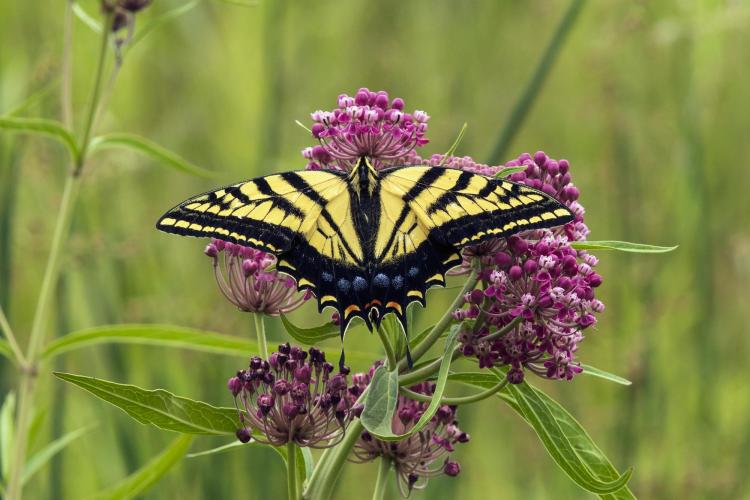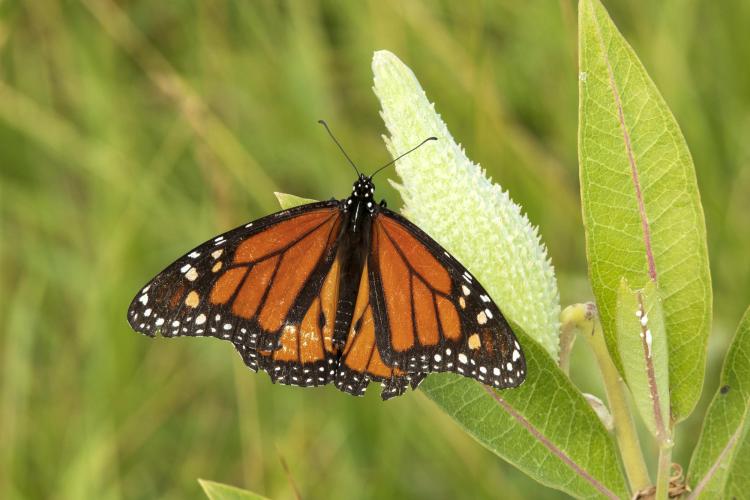Western tiger swallowtails sip milkweed nectar and chew aspen leaves
Monarch butterflies gained access to milkweeds after they evolved the metabolic trick of absorbing the cardiac glycosides by sequestering them in fat bodies
Two species of milkweeds are abundant and conspicuous from the plains of Colorado to the montane region of the Front Range. The showy milkweed, Asclepias speciosa, is common along roadsides and in moist meadows, where its large and bright globes of pink and pinkish purple flowers are readily apparent. The swamp milkweed, Asclepias incarnata, is semiaquatic, growing in marshes and beside creeks, where its rounded umbels of pink to reddish violet flowers are displayed on stalks reaching over five feet tall.
About 200 species of milkweeds are native to North America, South America and Africa and all are in the genus Asclepias. A trait common to species in this genus is white and sticky latex sap that spills from lesions. The sap contains defensive cardiac glycosides that are poisonous to many animals, but are sequestered into fatty tissues by the caterpillars of monarch butterflies, Danaus plexippus, where they serve as chemical defenses for both caterpillars and butterflies. Visually hunting predators learn that the brightly colored monarch caterpillars and butterflies are so distasteful and poisonous that they induce vomiting.
Milkweed's chemical defenses do not occur in either the pollen or nectar so the big, colorful clusters of flowers attract a wide range of insects, butterflies, bees and wasps. At this time of year, showy milkweeds are at the end of their flowering season, so flowers are gone or drying and the milkweed seed pods are inflating. Swamp milkweeds are flowering profusely now.

A western tiger swallowtail landing on Swamp Milkweed. Photo by Jeff Mitton.
During several visits to South Boulder Creek Trail recently, monarch butterflies and western tiger swallowtails, Papilio rutulus, were nectaring on swamp milkweed. This is common knowledge — online advice for planning butterfly gardens recommends planting both swamp milkweed and common milkweed, Asclepias syriaca.
Naturalists associate monarch butterflies with milkweeds because monarchs oviposit on common milkweeds, showy milkweeds and swamp milkweeds, and their caterpillars feed on the leaves. Although swallowtail butterflies consume milkweed nectar, swallowtail caterpillars are unable to feed on leaves of milkweeds. Instead, swallowtail butterflies employ aspen and cottonwoods and a variety of other trees for oviposition and larval feeding.
Western tiger swallowtails often employ quaking aspen for oviposition and larval feeding. But not all swallowtail species can tolerate aspen's chemical defenses. For example, in small portions of Colorado and South Dakota, the ranges of western and eastern tiger swallowtails overlap. In these areas the western swallowtail utilizes aspen and cottonwoods for oviposition and larval feeding, but the eastern tiger swallowtail, Papilio glaucus, does not.

Monarch butterfly on showy milkweed showing it's full wings. Photo by Jeff Mitton.
Laboratory studies showed that when eastern swallowtail caterpillars are fed aspen leaves about half of them die and none are able to metamorphose. Aspen synthesizes a group of toxic glycosides, most notably tremulacin and salicortin, that deter insect herbivory by decreasing both their food conversion efficiency and feeding rates. However, these compounds are not toxic to western tiger swallowtails and two closely related western species, Canadian tiger swallowtails, Papilio canadensis and pallid swallowtails, Papilio eurymedon.
Swallowtail butterfly species able to use aspen and cottonwoods for feeding have enzymes called esterases that detoxify tremulacin and salicortin. Eastern swallowtail butterflies lack the detoxifying esterases that enable western, Canadian, and pallid swallowtails to feed on leaves of aspen and cottonwood trees. It is likely that evolution of esterases enabled these western swallowtails to include aspen and cottonwoods in their menu of larval feeding hosts.
Milkweeds evolved latex sap laced with cardiac glycosides to deter herbivores from shredding their stalks and leaves. Monarch butterflies gained access to milkweeds after they evolved the metabolic trick of absorbing the cardiac glycosides by sequestering them in fat bodies. Aspen and cottonwoods deterred many herbivores by synthesizing a variety of toxic glycosides. Some species of swallowtail butterflies gained access to aspen and cottonwoods after they evolved enzymes that detoxify the cardiac glycosides. So, when we combine esoteric biochemistry with sophisticated evolutionary biology, we gain insight into natural history. We understand why monarchs oviposit on milkweeds, and why western tiger swallowtails, but not eastern tiger swallowtails, oviposit on aspen.

